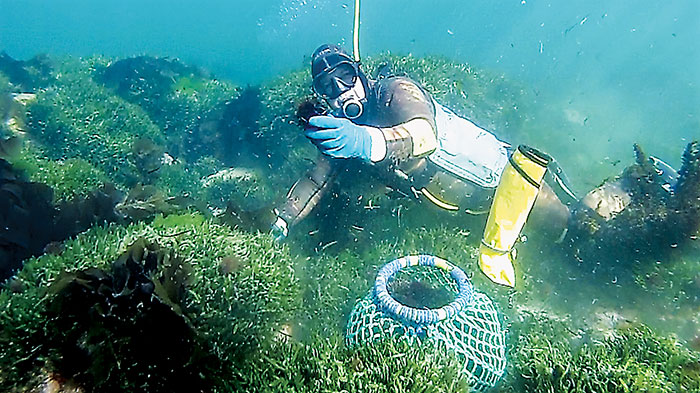Many Australians remain unfamiliar with sea urchin roe as an ingredient, but efforts to develop a quality product are paying dividends both economically and environmentally
 Diving for urchins has given Keith Browne a greater understanding of their impact on marine vegetation.
Diving for urchins has given Keith Browne a greater understanding of their impact on marine vegetation. Photo: John Minehan
By Annabel Boyer
Keith Browne is the co-owner of South Coast Sea Urchins, based at Merimbula on the NSW South Coast, where he and business partner Andrew Curtis have spent more than a decade developing wild-harvested Australian sea urchin roe into a viable business. Recently awarded a gold medal in delicious magazine’s produce awards, which spotlight new and native ingredients, produced with passion, knowledge and regard for the environment, things are starting to pay off.
Initially they supplied urchin roe mostly for the kina market. Kina is a lower-value product loved by the Maori population. But after a decade of product development, 45 per cent of their production is now higher-quality, higher-valued uni grade roe, favoured by the Japanese.
“The uni market is more about precision, getting the same size and same colour,” Keith Browne says.
The domestic market absorbs all of their production, with uni becoming a feature on the menus of many leading Australian restaurants.
South Coast Sea Urchins harvests two species of urchin – Centrostephanus rodgersii or Long-spined Sea Urchin and Heliocidaris erythrogramma or Purple Sea Urchin – at different times of the year. Keith Browne says the former is stronger in flavour and beloved of well-seasoned eaters of urchin roe, while Heliocidaris erythrogramma, which he harvests from Victoria, has a more subtle flavour and is in demand from high-end restaurants.
Harvest strategies
As an abalone diver, long before he thought of harvesting urchins, Keith Browne started to notice that abalone and rock lobsters were disappearing from the reefs he dived on and urchins were appearing in their place.
Sea urchins are voracious feeders and when in numbers can strip underwater reefs of most of their vegetation, leaving bare rock or barrens. The Long-spined Sea Urchin is particularly known for its devastation of underwater vegetation, but Keith Browne says both species can be damaging. “We learnt that by thinning urchins, the environment started to change; (it) started to revert back to what it was originally,” he says.
Fortuitously for South Coast Sea Urchins, healthier underwater environments produce better-quality urchin roe – a finding that has been confirmed by FRDC research. Keith Browne also contributed to the project, designed to develop and manage the sea urchin fisheries of NSW and eastern Victoria. The research found that roe quality improved when the concentration of urchins in barrens was reduced and when ‘transplanting’ them to fringe areas.
Multiple FRDC research projects have investigated sea urchins in NSW and Tasmania to understand how they interact with other species such as abalone and rock lobsters and how they impact on marine vegetation. As these relationships have become better understood, projects have also examined the viability of harvesting sea urchin fisheries and establishing sea urchin fisheries.
South Coast Sea Urchins maintains detailed maps of the coastal areas it fishes on the NSW South Coast and in Victoria’s Port Phillip Bay. Keith Browne assigns divers to ‘manage’ and harvest specific areas so that the divers become attuned to how the environment changes in their area and the kinds of urchins, and roe, that environment produces.
He says that when divers first start working for him, they tend to harvest as many urchins as they can. But as they learn more about urchins and roe and how the available feed and environment influence roe quality, the divers refine how they fish, taking smaller quantities of higher-quality urchin. In turn they make more money.
He says the divers monitor their fishing areas every year, thinning urchins to maintain the vegetation, which adds value to the remaining urchins in the form of higher-quality roe down the track. “There is a lot of thinking that goes on behind the scenes, because if you don’t do that, the quality suffers badly and then the customers don’t want the product,” Keith Browne says.
FRDC Research Codes: 1993-221, 1999–128





